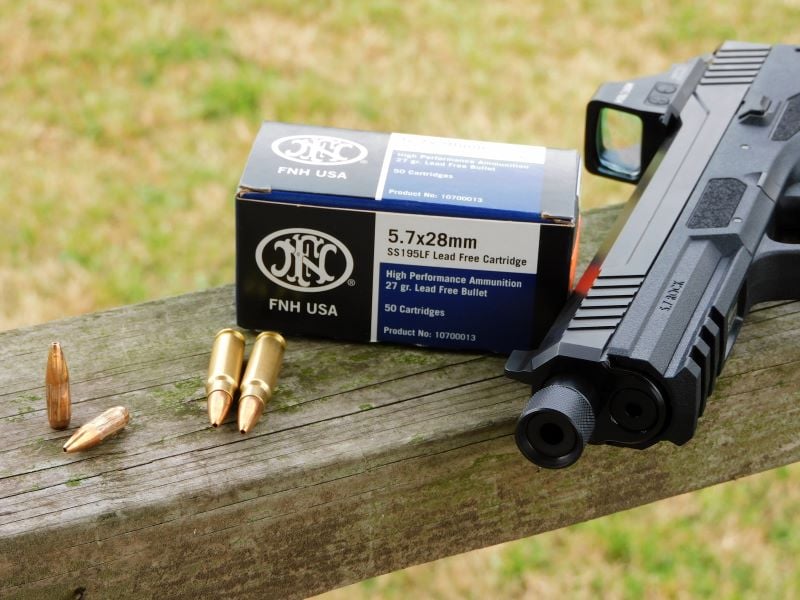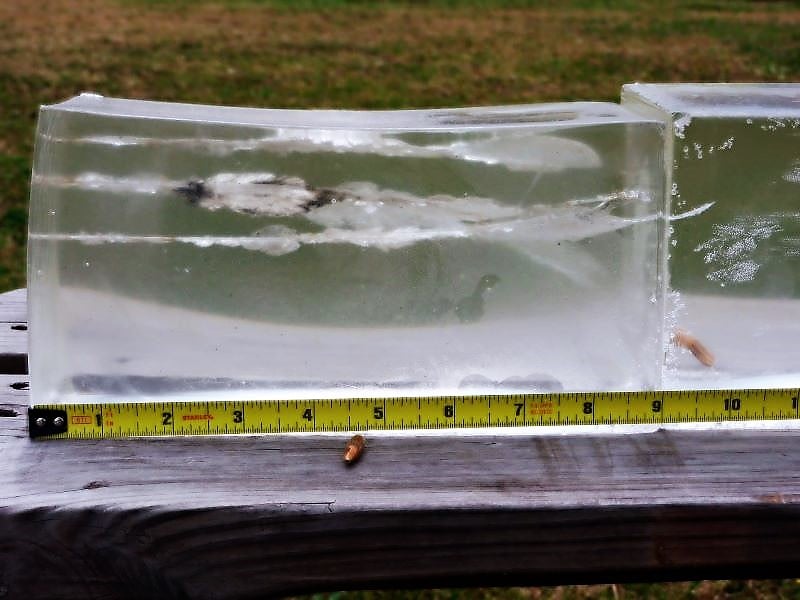The 5.7x28mm FN cartridge has been getting a lot of love over the last few years. Designed back in 1990 by FN Herstal as a barrier-insensitive replacement for the 9mm Luger pistol cartridge, the 5.7 never became NATO standard. But this high velocity, bottlenecked mini-rifle round has gained a cult following in the US.
The 5.7 is in the light and fast power school and pistols chambered for it are praised for its low recoil and rich capacity over 9mm alternatives. Since 2019, pistols like the Ruger 57, PSA Rock, and Smith & Wesson 5.7, have come on the market to satisfy demand. Ammo selection is also growing, but still somewhat limited, as are tests on the ammunition. After acquiring my first 5.7mm pistol, I decided on a series of gelatin and barrier tests using different kinds of 5.7x28mm. In this review, we will take a look at a standard FN load: the SS195LF 27-grain jacketed hollow point.

The Load
FN loaded a few different types of 5.7x28mm ammunition from its debut ranging from 27 grains to 40 grains. The SS195LF falls into the lighter-for-caliber category and is a replacement for the older SS192 load developed in the 1990s. That load used a copper jacketed hollow point and an aluminum core. This round was created for shooting the FN Five Seven pistol where lead contamination would be a concern. In 2004, FN dropped the load and debuted the SS195LF. Since 2006, Fiocchi USA has produced the load under the FN banner. The SS195LF round comes in boxes of fifty and utilizes the same aluminum-core projectile as the SS192. The new load does, however, utilize lead-free primers. Otherwise, both rounds are ballistically identical.

Shooting Characteristics
Out of an FN PS90, the SS195LF round achieves a muzzle velocity of about 2500 feet per second; roughly 300 feet per second faster than a comparably light load from a 22 Magnum rifle. Using my PSA Rock with a 5¼ inch barrel, I fired five rounds over my Caldwell Chronograph. The load ran at an average velocity of 2168 feet per second. That is rifle velocity, but it is done with a light-for-caliber bullet. Indeed, shooting the SS195 load back-to-back with standard 40-grain loads, I noticed less perceived recoil.
Accuracy is going to be subjective from person to person and firearm to firearm, but I found the 27-grain load hit to the same point of aim as 40-grain loads; while my groups at 10 yards with the latter loads were marginally better. But I could reliably put five rounds of the SS195 into a 1.8-inch pattern—plenty of accuracy, at least for me.
The Test

Given the astonishing high velocity of this load, I fronted my 10% Clear Ballistics gelatin blocks with four layers of denim and prepared to kiss that front block goodbye. Light, fast loads, regardless of caliber, tend to dump much of their energy quickly, whether in gel or in game.
I fired four rounds of the SS195 into my blocks from ten yards away. The impact was enough to blow my denim off the blocks, so I had to reset for every shot. My first shot escaped the block at the 10-inch mark, and my second round stuck half-in-and-half-out of the right side of the block at the 8½-inch mark. The third shot dislodged the second round and exited the block close by. My final round landed base first at the 10-inch mark.

As I expected, the first block took almost all the damage. What I did not expect is the violent tumbling that caused the projectiles to run off a straight wound tract. From the 3½ to 9-inch mark, the tracts dipped in every direction and left one-inch cavities throughout, indicating the projectiles were yawing as they lost their energy.
The recovered projectiles were not damaged and there was no expansion of the hollow point, though I suspect this type of hollow point was designed to increase accuracy over distance and encourage tumbling, rather than expansion as we typically encounter in typical handgun cartridges.

Parting Shots
Out of a typical 5.7x28mm handgun like the PSA Rock, the SS195LF ammunition gives you 22 Magnum recoil and velocity, as if the latter was fired from a rifle. I am a fan of the 22 Magnum, both out of a handgun and out of a rifle, but the round in no way equals the damage of the 5.7×28 SS195 load. The hollow-point spitzer round is longer than your typical 22 Magnum 30-grain V-Max and is far more explosive at dumping its energy and tumbling.
Compared to more typical 40-grain 22 Magnum and 5.7x28mm ammunition, the SS195 sacrifices penetration for damage. In short, it behaves like an excellent varmint round that may be light for personal protection. No matter what use you might have for the SS195, all I will say is that I do not want to be on the wrong end of it.

